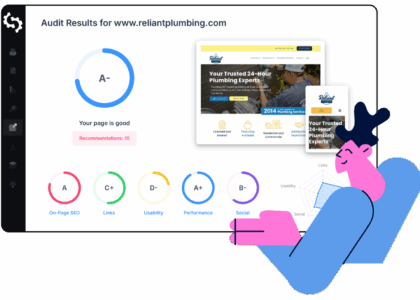The Significance of Website Analysis
Website analysis is a crucial process that helps businesses understand the performance and effectiveness of their online presence. By examining various metrics and data points, organisations can gain valuable insights into user behaviour, traffic sources, conversion rates, and more.
Key Benefits of Website Analysis:
- Optimising User Experience: By analysing user interactions and behaviour on a website, businesses can identify areas for improvement to enhance the overall user experience.
- Increasing Conversion Rates: Understanding which pages or elements drive conversions allows companies to make data-driven decisions to optimise their conversion funnels.
- Improving SEO Performance: Website analysis helps in identifying SEO opportunities and issues that may be affecting search engine rankings. This enables businesses to refine their SEO strategies for better visibility.
- Enhancing Marketing Strategies: By tracking website traffic sources and engagement metrics, organisations can evaluate the effectiveness of their marketing campaigns and make adjustments as needed.
- Monitoring Competitor Performance: Comparative website analysis provides insights into how competitors are performing online, allowing businesses to benchmark their own performance and identify areas for growth.
The Process of Website Analysis:
The website analysis process typically involves collecting data using web analytics tools such as Google Analytics, interpreting the data to draw meaningful conclusions, and implementing changes based on insights gained. It is an iterative process that requires continuous monitoring and adjustment to achieve optimal results.
In conclusion, website analysis is an essential tool for businesses looking to maximise their online presence and drive growth. By leveraging data-driven insights, organisations can make informed decisions that lead to improved user engagement, increased conversions, and a competitive edge in the digital landscape.
Essential FAQs on Website Analysis: Enhancing User Experience, SEO, and Marketing
- What is website analysis and why is it important?
- How can website analysis help improve user experience?
- What are the key metrics to consider in website analysis?
- How does website analysis contribute to improving SEO performance?
- What tools are commonly used for website analysis?
- How often should website analysis be conducted?
- Can website analysis help identify areas for marketing improvement?
- What are the benefits of conducting competitor analysis as part of website analysis?
What is website analysis and why is it important?
Website analysis is the process of evaluating and interpreting data related to a website’s performance and effectiveness. It involves examining various metrics such as traffic sources, user behaviour, conversion rates, and SEO performance to gain insights into how well a website is meeting its objectives. Understanding website analysis is crucial for businesses as it provides valuable information that can help in optimising user experience, increasing conversion rates, improving search engine rankings, enhancing marketing strategies, and staying competitive in the online space. By regularly analysing their websites, organisations can make data-driven decisions to drive growth and achieve success in the digital realm.
How can website analysis help improve user experience?
Website analysis plays a vital role in enhancing user experience by providing valuable insights into how visitors interact with a website. By analysing user behaviour, such as page views, bounce rates, and time spent on each page, businesses can identify areas for improvement to make the website more user-friendly and engaging. Understanding which pages are most visited, where users drop off, and what actions lead to conversions allows companies to tailor their content and design to meet the needs and preferences of their target audience. Through website analysis, businesses can create a seamless and intuitive user experience that fosters engagement, builds trust, and ultimately leads to higher satisfaction levels among visitors.
What are the key metrics to consider in website analysis?
When conducting website analysis, it is essential to consider a range of key metrics to gain a comprehensive understanding of the site’s performance. Some of the critical metrics to evaluate include website traffic, which provides insights into the volume and sources of visitors, bounce rate to assess user engagement, conversion rates to measure the effectiveness of calls-to-action, average session duration indicating user interaction, and page load times for assessing site speed. Additionally, analysing demographics, behaviour flow, and top-performing content can offer valuable insights for optimising the website’s overall effectiveness and user experience. By carefully examining these key metrics, businesses can make informed decisions to enhance their online presence and achieve their digital marketing goals.
How does website analysis contribute to improving SEO performance?
Website analysis plays a crucial role in enhancing SEO performance by providing valuable insights into various aspects of a website’s online presence. Through website analysis, businesses can identify key SEO opportunities and issues affecting their search engine rankings. By examining metrics such as organic traffic, keyword performance, backlink quality, and on-page optimisation, organisations can pinpoint areas for improvement and refine their SEO strategies accordingly. This data-driven approach enables businesses to make informed decisions to boost their visibility in search engine results pages, ultimately driving more organic traffic to their website and improving overall SEO performance.
What tools are commonly used for website analysis?
One frequently asked question regarding website analysis is, “What tools are commonly used for website analysis?” Various web analytics tools are widely utilised to gather and interpret data for website analysis. Popular tools such as Google Analytics, Adobe Analytics, and SEMrush provide valuable insights into website traffic, user behaviour, conversion rates, and more. These tools offer a comprehensive range of features that enable businesses to track key metrics, monitor performance trends, and make informed decisions to optimise their online presence effectively. By leveraging these tools, organisations can gain a deeper understanding of their website performance and implement strategies to enhance user experience and drive business growth.
How often should website analysis be conducted?
Regular website analysis is essential for businesses to stay informed about their online performance and make data-driven decisions. The frequency of conducting website analysis depends on various factors, including the size of the business, the industry it operates in, and its online goals. In general, it is recommended to perform website analysis at least once a month to track trends, identify emerging issues, and measure the effectiveness of ongoing strategies. However, for businesses with high web traffic or those running dynamic digital campaigns, more frequent analysis on a weekly or even daily basis may be necessary to ensure timely adjustments and maximise results. Ultimately, the key is to establish a consistent schedule for website analysis that aligns with business objectives and allows for continuous improvement in online performance.
Can website analysis help identify areas for marketing improvement?
Website analysis plays a pivotal role in identifying areas for marketing improvement. By examining key metrics such as traffic sources, user engagement, conversion rates, and bounce rates, businesses can gain valuable insights into the effectiveness of their marketing strategies. Through website analysis, organisations can pinpoint underperforming areas, identify opportunities for growth, and make data-driven decisions to optimise their marketing efforts. This process enables businesses to refine their targeting, messaging, and overall marketing approach to enhance performance and achieve better results in reaching their target audience.
What are the benefits of conducting competitor analysis as part of website analysis?
Conducting competitor analysis as part of website analysis offers several key benefits. By evaluating competitors’ online strategies, businesses can gain valuable insights into industry trends, best practices, and areas for improvement. This information allows companies to benchmark their own performance against competitors, identify unique selling points, and discover new opportunities for growth. Additionally, competitor analysis helps businesses understand the competitive landscape better, enabling them to refine their marketing strategies, improve website functionality, and stay ahead in the market. Overall, incorporating competitor analysis into website analysis provides a comprehensive view of the digital ecosystem and empowers businesses to make informed decisions that drive success.






